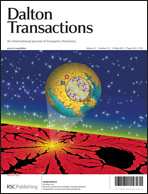Enzymes in the oxygen-activating class of mononuclear non-heme iron oxygenases (MNOs) contain a highly conserved iron center facially ligated by two histidine nitrogen atoms and one carboxylate oxygen atom that leave one face of the metal center (three binding sites) open for coordination to cofactor, substrate, and/or dioxygen. A comparative family of [FeII/III(N2On)(L)4−n)]±x, n = 1–3, L = solvent or Cl−, model complexes, based on a ligand series that supports a facially ligated N,N,O core that is then modified to contain either one or two additional carboxylate chelate arms, has been structurally and spectroscopically characterized. EPR studies demonstrate that the high-spin d5 FeIIIg = 4.3 signal becomes more symmetrical as the number of carboxylate ligands decreases across the series Fe(N2O3), Fe(N2O2), and Fe(N2O1), reflecting an increase in the E/D strain of these complexes as the number of exchangeable/solvent coordination sites increases, paralleling the enhanced distribution of electronic structures that contribute to the spectral line shape. The observed systematic variations in the FeII–FeIII oxidation–reduction potentials illustrate the fundamental influence of differential carboxylate ligation. The trend towards lower reduction potential for the iron center across the [FeIII(N2O1)Cl3]−, [FeIII(N2O2)Cl2]− and [FeIII(N2O3)Cl]− series is consistent with replacement of the chloride anions with the more strongly donating anionic O-donor carboxylate ligands that are expected to stabilize the oxidized ferric state. This electrochemical trend parallels the observed dioxygen sensitivity of the three ferrous complexes (FeII(N2O1) < FeII(N2O2) < FeII(N2O3)), which form μ-oxo bridged ferric species upon exposure to air or oxygen atom donor (OAD) molecules. The observed oxygen sensitivity is particularly interesting and discussed in the context of α-ketoglutarate-dependent MNO enzyme mechanisms.

You have access to this article
 Please wait while we load your content...
Something went wrong. Try again?
Please wait while we load your content...
Something went wrong. Try again?


 Please wait while we load your content...
Please wait while we load your content...